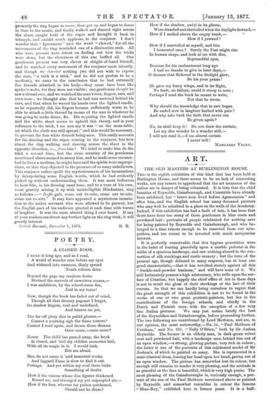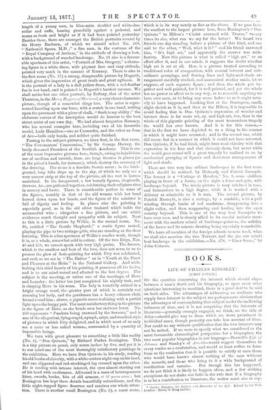ART.
THE OLD MASTERS AT BURLINGTON HOUSE.
Tars is the eighth exhibition of this kind that has been held at. Burlington House, and there seems to be no lack of interesting works, nor any reason to apprehend that the art treasures of the nation are in danger of being exhausted. It is true that the chief beauties of Reynolds, Gainsborough, and Constable have already been exhibited, but " brave men lived before Agamemnon " and. after him, and the English school has many deceased painters who may well be admitted to a place on the walls of the Academy.. Indeed, if this exhibition has had a fault of late, it has been that there have been too many of these gentlemen in blue coats and powdered hair ; portraits of people celebrated for nothing save- for being painted by Reynolds and Gainsborough, and who be- longed to a time remote enough to be removed from our sym- pathies, and too recent to be invested with much antiquarian• interest.
It is perfectly conceivable that this bygone generation were in the habit of leaning gracefully upon a marble pedestal in the midst of a spacious landscape, and saw nothing absurd in the con- nection of silk stockings and rustic scenery ; but the taste of the present age, though debased in many respects, has at least one good characteristic,—that it has revolted sternly against all this. " buckle-and-powder business," and will have none of it. We still fortunately possess a high aristocracy, who trifle upon the sur- face of Creation, but happily the chief office of Art in these days is not to recall the gloss of their stockings or the lace of their cravats. So that we can hardly bring ourselves to regret that the great strength of this exhibition is not to be found in the works of one or two great portrait-painters, but lies in the- contributions of the foreign schools, and chiefly in the Dutch and Flemish ones, with the exception of a few very
fine Italian pictures. We may just notice briefly the best of the Reynoldses and Gainsboroughs, before proceeding further. The two following are contributed by Lord Methuen, and are, in our opinion, the most noteworthy,—No. 54, " Paul Methuen of Corsham," and No. 195, " Nelly O'Brien," both by Sir Joshua. Reynolds. The former is an elderly man, in dark-green velvet coat and powdered hair, with a landscape seen behind him out of an open window,—a strong, glowing picture, very rich in colour ;- the latter is one of the portraits of this celebrated model of Sir Joshua's, of which he painted so many. She is represented in a. semi-classical dress, leaning her head upon her hand, gazing out of an open window. The picture has somewhat lost its colour, but- enough still remains to render it very pleasing, and the attitude is. as graceful as the face is beautiful, which is very high praise. The most pleasing of the Gainsboroughs is, curiously enough, a por- trait of the son of the Paul Methuen mentioned above as painted by Reynolds, and somewhat resembles in colour the famous- " Blue-Boy," exhibited here in former years. It is a half- length of a young man, in blue-satin doublet and white-lace collar and cuffs, leaning gracefully against a pedestal, and seems as fresh and bright as if it had been painted yesterday- Besides these, there are amongst the British portraits several by Sir Henry Raeburn, of which we should select No. 268, "Nathaniel Spens, M.D. ;" a fine man, in the costume of the "Royal Company of Archers," in the attitude of drawing a bow, with a background of wooded landscape. No. 91 also is a favour- able specimen of this artist, "Portrait of Mrs. Gregory," a charm- ing figure in a white dress, with piquant face and easy attitude, painted very much in the manner of Romney. There is also in the first room (No. 17) a strong, disagreeable picture by Hogarth, which gives the impression of great truth and great ugliness. It is the portrait of a lady in a dull yellow dress, with a red-feather fan in her hand, and is painted in Hogarth's hardest manner. We shall notice but one other portrait, by Zoffany, that of the actor Thurston, in the Merry Beyyar$ of Sherccood, a very clever character- picture, though of a somewhat dingy hue. The actor is repre- sented kneeling upon one knee, with a crutch in one hand, writing upon the pavement with a piece of chalk, " Such is my ability ;" the elaborate curves of the inscription would do honour to the best street-artist of our own day. We had almost forgotten Romney, who has several examples here, including two of his favourite model, Lady Hamilton—one as Cassandra, and the other as Joan of Arc—both only heads, and neither quite finished.
Passing to the subject-pictures, we have first, in the first room, "The Covenanters' Communion," by Sir George Harvey, the lately deceased President of the Scottish Academy. This is one of the most impressive pictures here, though, owing to injudicious use of medium and varnish, there are large fissures in places (as in the priest's hands, for instance), which destroy the accuracy of the drawing. The scene is a desolate Scotch moor ; in the back- ground, long hills slope up to the sky, of which we only see a very narrow strip at the top of the picture, all the rest is barren moorland. In the foreground, a few homely figures, shepherds, drovers, &c., are gathered together, celebrating their religious rites in secrecy and haste. There is considerable pathos in some of the figures, notably in that of the old woman with her head bowed down upon her hands, and the figure of the minister is full of dignity and feeling. In places also the painting is especially good, as in the old silver tankard which holds the sacramental wine ; altogether a fine picture, and one which evidences much thought and sympathy with its subject. Next to this is a little picture by Wilkie, in the second room, No. 89, entitled "The Gentle Shepherd ;" a rustic figure seated, playing the pipe to two cottage-girls, who are standing at the door listening. This is afine specimen of Wilkie's smaller work, though
it is, as a whole, somewhat cold in colour. Of the two Ettys, Nos. 46 and 238, we cannot speak with very high praise. The former, which is the smallest and best of the two, does not seem to us to possess the glow of flesh-painting for which Etty was celebrated, and such as we see in "The Bather" or in "Youth at the Prow and Pleasure at the Helm" in the National Gallery. And while lacking this chief beauty of his painting, it possesses all his faults, and is to our mind unreal and affected to the last degree. The subject is the meeting, or rather one of the meetings, of Hero and Leander ; the latter has just completed his nightly task, and is clasping Hero in his arms. The lady is tastefully attired in a bright orange scarf, the greater part of which is certainly not covering her body, and the gentleman has a heavy crimson cloth bound round him ; above, a gigantic moon is shining with a partial light upon the happy pair. The most satisfactory thing in the picture is the figure of Hero, as she bends over her stalwart lover. No. 258 represents " Pandora being crowned by the Seasons," and is one of the allegorical, flying-cupid, nymph, satyr, and rosebud style of pictures in which Etty delighted, and in which most of us only ' see a more or less naked woman, surrounded by a quantity of impossible beings.
We turn with great pleasure to something a little like reality (No. 4), "Don Quixote," by Richard Parkes Bonington. This is a tiny picture on panel, only seven inches by five, and yet it is to our mind one of the most thoroughly satisfactory paintings in the exhibition. Here we have Don Quixote in his study, reading his old books of chivalry, with a white-cotton night-cap on his head, and one slippered and red-stockinged leg crossed upon the other. He is reading with intense interest, the eyes almost starting out of his head with excitement. All round is a mass of heterogeneous litter, swords, books, bits of old armour, ct id genus omne ; but Bonington has kept these details beautifully subordinate, and the little night-capped figure deserves and receives our whole atten- tion. There is another small Bonington (No. 5), a coast scene,
which is in its way nearly as fine as the above. If we pass from the smallest to the largest picture here, from Bonington's " Don Quixote" to Hilton's " Christ crowned with Thorns," twenty times its size, what can we say for the latter? We heard two friends one day standing before a picture of this kind, and one said to the other, " Well, what is it? " and his friend answered him, " It's high art," and apparently the answer was satis- factory. Now this picture is what is called "high art," or an effort after it, and to our minds, it suggests the doubt whether high art is art at all. Here is a picture treated according to traditional rules of composition, with central interest and sub- ordinate groupings, and flowing lines and light-and-shade ar- rangement carefully studied, and anatomical studies made, let us suppose, of each separate figure ; and then the whole put to- gether and well painted, for it is well painted, and yet the whole has no power to affect us in any way, or to resemble anything we have ever seen, or to bring any scene before us as it ought actu- ally to have happened. Looking first at the Bonington, small, slight sketch as it is, and then at the Hilton, it is impossible to avoid feeling that in Don Quixote's expression of wonder and interest there is far more art, ay, and high art, too, than in the whole of this gigantic painting of the most tremendous tragedy the world has ever known. And it is for this reason,— that in the first we have depicted to us a thing in the manner in which it might have occurred ; and in the second one, which did occur, but in a manner in which it could not have occurred. Don Quixote, if he had lived, might have read chivalry with that expression in his face and that slovenly dress, but never while the world goes round will a great tragedy be realised to us by mechanical grouping of figures and dexterous arrangements of light and shade.
There are two very fine cabinet landscapes in the first room which should be noticed, by Muiready and Patrick Nasmyth. The former is a "Cottage at Hendon," No. 8, some children playing in front of a house, on the right a fence and gate, with landscape beyond. The whole picture is very subdued in tone, and harmonious to a high degree, while it is worked with a delicacy as admirable as it is rare. The second picture, by Patrick Nasmyth, is also a cottage, by a roadside, with a path winding through banks of red sandstone, disappearing into a slight valley, and then reappearing and leading into the open country beyond. This is one of the very best Nasmyths we have ever seen, and is closely allied in its careful realistic treat- ment with the modern school of landscape-painters, the solidity of the house and its minute drawing being especially remarkable.
Wee leave all mention of the foreign schools to next week, when we shall also mention the two Turners, and the (to our mind) best landscape in the exhibition,—No. 278, " River Scene," by John Cotuaan.







































 Previous page
Previous page